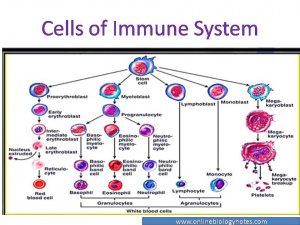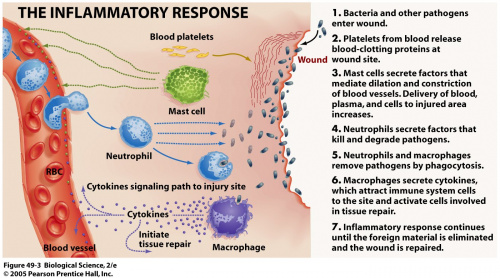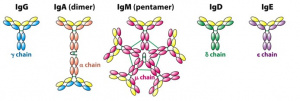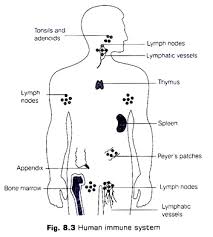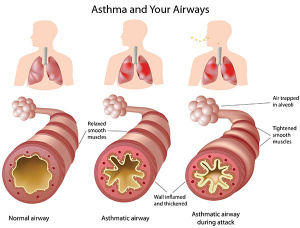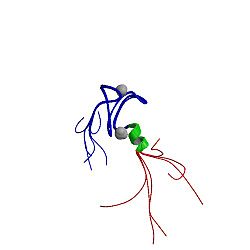Anatomy/Immune System
The immune system is a focus topic of the event Anatomy. It will come into rotation for the 2018 season. The immune system is composed of cells, tissues, and organs that work together to defend the body against attacks by “foreign” invaders.
Overview
The immune system protects the body from disease and potentially harmful foreign invaders called pathogens. There are five types of pathogens which include bacteria, viruses, fungi, protozoa, and helminths (worms). The first 3 are often referred to as microorganisms, and the latter 2 are also known as parasites. The process through which pathogens cause disease is called pathogenesis.
The immune system defends against pathogens two ways: preventing foreign organisms from entering the body and destroying harmful organisms that do enter the body. It detects pathogens and differentiates between potentially harmful agents and the body's own healthy tissues. When the immune system cannot differentiate harmful foreign invaders and its own cells, it is an autoimmune disease. It creates an immune response to itself.
The Immune System
There are 3 levels of the immune system. The first two are nonspecific (or innate), meaning they defend against all kinds of pathogens. The third is specific (also adaptive or acquired), because it identifies and targets certain pathogens. As people age, their specific immune systems adapt to the pathogens they encounter, which decreases the likelihood of getting sick from previously-encountered pathogens.
First Line of Defense
The first line of defense is made up primarily of the skin, mucous membranes, and their secretions. They protect against external pathogens from entering the body. Here are some examples:
- The skin is a physical barrier made of dead cells. It secretes oily and acidic secretions from sweat glands, which inhibit bacterial growth.
- Sebum (unsaturated fatty acids) provides a protective film on the skin and inhibits growth
- Secretions from mucous membranes (saliva, tears, sweat, etc.) contain antimicrobial proteins such as lysozyme, which breaks down bacterial cell walls.
- Vibrissae (nose hair) filters microbes, dust, and pollutants within air.
- Cilia that line the lungs traps and moves foreign substances out from the lungs towards the throat with a sweeping motion.
- Gastric juice, which is highly acidic, kills microbes in the stomach.
- Symbiotic bacteria in the digestive tract and vagina out-compete other potentially harmful organisms.
- Urine flushes microbes from the urethra.
- Defecation and vomiting also expel microorganisms.
Second Line of Defense
The second line of defense deals with pathogens that have entered the body. It involves several nonspecific mechanisms.
- Phagocytes are white blood cells (leukocytes) which engulf pathogens by extending pseudopods to surround it. This process is called phagocytosis. Leukocytes are formed in stem cells in bone marrow through the process of hematopoiesis (this term refers to all blood cells).
- Macrophages are larger, long-living versions of monocytes. Monocytes circulate through the blood stream, and are known as macrophages when they mature. Macrophages move throughout blood, lymph, and body tissues. They are specialized in the removal of dying or dead cells and cellular debris as well as pathogens. Macrophages also play an important role in chronic inflammation.
- Neutrophils are the most abundant type of white blood cell. They are normally present in the blood stream, but quickly enter tissues to phagocytize pathogens, primarily bacteria, in acute inflammation. They respond within minutes to the site of injury.
- MAST Cells also secrete histamine, as well as serotonin. They help cause inflammation and respond to wound injuries.
- Dendritic Cells are the messengers between the innate and adaptive immune systems. Dendritic cells acquire and present antigens to lymphocytes to activate them.
- Basophils and Eosinophils are also white blood cells, but are not phagocytes. Basophils secrete chemicals such as histamine. Histamine triggers vasodilation, causing more phagocytes to be brought into the area. Histamine is also known as being responsible for the symptoms of allergies and the common cold. Eosinophils are short-lived and have a wide range of functions, including attacking parasites and helping with allergic responses. The proteins they make can be harmful to the body's own tissues as well as pathogens.
- Natural Killer Cells (NK cells) attack abnormal or pathogen-infected body cells, such as tumors, by releasing toxic granules to kill the cells.
- The Complement System is a group of about 30 proteins which assist defense reactions. They help by enhancing the process of phagocytosis, attracting phagocytes to foreign cells, and promoting cell lysis. They are generally synthesized by the liver.
- Interferons are secreted by cells invaded by a virus. They stimulate neighboring cells to produce proteins that will help defend against the viruses.
- Chemokines guide the movement of cells. Cells respond to certain chemokines by moving towards areas of higher concentrations of chemokines. In the immune system, they create a chemical gradient to attract neutrophils and other leucocytes to the wound site.
- Fevers are an increase in body temperature. Substances that induce fevers are called pyrogens. The increased temperature inhibits bacterial growth and increases the rate of tissue repair during an infection. It may also help certain types of immune cells function more efficiently.
The Inflammatory Response
The inflammatory response is the biological response to harmful stimuli, such as burns, chemical irritants, frostbite, physical injury, or pathogen infection. (Given this is the Immune System page, this section will focus on the inflammatory response to pathogen infection.) It is characterized by swelling, pain, redness, warmth, and dysfunction of organs involved (tumor, dolor, rubor, calor, and functio laesa, respectively). Its purpose is to increase blood supply to the area to bring nutrients, proteins, and white blood cells to the affected tissues. Note that the epithelium and the capillaries are separated by interstitial fluid rather than being located right next to each other. In the example a splinter, the following events occur as part of the inflammatory response:
- 1. Damaged cells release chemokines.
- 2. MAST cells, responding to chemokines, direct contact with the splinter, or bacteria, release histamine.
- 3. Histamine causes capillary endothelial cells to enlarge and move outwards, creating a swell in the capillary which encourages fluid collection. The capillary walls also become more porous. This process is called vasodilation. Vasodilation causes redness, temperature increase and swelling. The increase in temperature causes an increased metabolic rate in cells. Activated capillary endothelial cells also display adhesion molecules called selectins on the inner capillary surface.
- 4. Phagocytes, namely neutrophils, are attracted to, slowed down by, and roll along the wall due to the selectins. Chemicals in the bloodstream activate integrins, adhesion receptors on neutrophils. The integrins then bind to adhesion receptor molecules on the capillary endothelial cell surfaces. The accumulation and adhesion of leukocytes to the blood vessel walls is called margination or pavementing.
- 5. Leukocytes squeeze through openings in the capillary walls (extravasation, emigration, or more specifically diapedesis). Exudation, or the entering of fluid from the bloodstream into the interstitial fluid, also occurs. This fluid, mainly plasma, contains proteins and antibodies. Fluid buildup due to exudation is called an edema and is visible as a swelling (tumor). The plasma also help activate the complement, kinin (generates proteins that sustain physical inflammatory effects, namely vasodilation), coagulation (clotting), and fibrinolysis (counter-balances the coagulation effect) systems.
- 6. Neutrophils and other phagocytes attack invading bacteria that have entered due to the splinter. Complement helps phagocytes engulf foreign cells, and stimulates additional histamine secretion by basophils.
The inflammatory response (and the immune system in general) often consists of reactions to certain stimuli which in turn cause more reactions. Signaling pathways like this can be referred to as biochemical cascades.
The Immune Response
The Immune response is the third line of defense. It is a specific defense system, meaning it targets specific antigens. Antigens are molecules, usually proteins or polysaccharides, that are identified as foreign to the body. These molecules could be toxins, part of a viral protein cote, or molecules unique to certain bacteria, protozoa, pollen, or other foreign cells.
MHC
The major histocompatibility complex, or MHC, is the mechanism the immune system uses to differentiate between self and foreign cells. It is a collection of glycoproteins that are displayed on the cell membranes of every body cell. MHC molecules display protein fragments from inside the cell. These molecular protein fragments are known as epitopes. Each individual has a highly unique (but not always, especially in the case of identical twins) set of MHC molecules. T-cells interact with MHC molecules and "read" the epitopes to ensure that foreign invaders are not present in the cells. There are three classes of MHC, but only MHC I and MHC II play a role in immunity:
MHC Class I
All nucleic cells in the body, which includes all cells except for erythrocytes, display MHC Class I protein fragments. Cytotoxic T-cells will dock their CD8 receptors to the MHC molecules, which allows the T-cell receptors to connect with the epitope. If the T-cell receptors fit the epitope, the cytotoxic T-cell will trigger apoptosis, which is programmed cell death. Otherwise, the cytotoxic T-cell will move on to another cell. This is how cytotoxic T-cells play a role in adaptive immunity, because the shape of the T-cell receptors varies for each antigen that T-cells encounter.
MHC Class II
MHC Class II is typically displayed by antigen-presenting cells, or APCs: B-cells, macrophages, and dendritic cells. After an APC consumes an antigen, the proteins in the antigen are broken up and displayed as epitopes on the Class II MHC molecules of the APC. Helper T-cells will dock their CD4 receptors to MHC Class II molecules. If the helper T-cell is "naive" and has not been exposed to any antigens, the T-cell receptors will bind to the epitope and learn to recognize that particular antigen. This activates the helper T-cell, which can now start secreting cytokines and multiplying itself. The cytokines tell nearby B-cells and cytotoxic T-cells to look for that antigen and kill it via apoptosis or antibody production.
Lymphocytes and their Components
Lymphocytes are white blood cells that concentrate in lymphatic tissues such as the lymph nodes, thymus gland, and the spleen. They are the primary agents of the immune response.
- B cells originate and mature in bone marrow (think: "B" for bone). They respond to antigens using specialized proteins called antibodies on their plasma membrane surface.
- Plasma cells: release speciic antibodies which circulate through the body, binding to antigens
- Memory cells: long-living B cells that do not release antibodies but circulate through the body and respond to subsequent invasions. Memory B cells provide immunity, as their response is much more quick and powerful than the first occurrence.
- The antibodies, or immunoglobulins(Ig) of B cells are antigen receptors only to a particular antigen. Antibodies inactivate antigens by binding to them, stimulating complement proteins to promote macrophage phagocytosis. There are 5 classes of antibodies, each a variation of the basic Y-shaped protein with variable regions which give them specificity to antigens. The 5 classes are as follows:
- IgA: second most common, major class of Ig in secretions like mucus
- IgD: not very common, mainly found on B cell surfaces
- IgE: least common, involved in allergic reactions, helpful in diagnosing parasites
- IgG: most common and versatile, only class transferred across placenta, is an opsonin (enhances phagocytosis)
- IgM: third most common, first made by fetus, good at clumping microorganisms in preparation for excretions
- T cells originate in the bone marrow but mature in the thymus gland (think: "T" for thymus). They have antigen receptors which are not antibodies but recognition sites for molecules displayed by nonself cells. Nonself cells, such as invaded body cells, cancer cells and tissue transplant cells, display different markers than self cells. When T cells encounter a nonself cell, they divide and produce two kinds of cells:
- Cytotoxic T cells or killer T cells destroys nonself cells by causing them to lyse.
- Helper T cells stimulate proliferation of B cells and cytotoxic T cells.
Clonal Selection
When an antigen binds to a B cell or a nonself cell binds to a T cell, the B or T cell divides to produce many identical copies. This results in an increased number of the B or T cell that can respond to the specific antigen.
Cell-Mediated Response
The cell-mediated response occurs as a response to nonself cells, and involves mainly T cells.
- 1. In a celluar infection, antigens are broken down by the cell and presented at the cell surface by class I MHC proteins.
- 2. T cells bind to the MHC detect antigens and undergo clonal selection, initiating the production of cytoxic T cells and helper T cells.
- 3. Helper T cells bind to macrophages which are displaying marker combinations which signal with marks that they have engulfed a pathogen.
- 4. Helper T cells produce interleukins, communication chemicals, to stimulate T cell and B cell proliferation. This initiates a posive-feedback cycle, increasing the concentratin of leukocytes in the area.
Humoral Response
The humoral response, or antibody-mediated response occurs as a response to antigens or pathogens circulating in the blood or lymph.
- 1. An antigen is engulfed by a phagocyte. It displays the antigen on its surface using a class II MHC protein.
- 1. B cells recognize the antigen and produce plasma cells, which release antibodies that bind with antigens or antigen-carrying pathogens.
- 2. B cells produce memory cells, providing future immunity.
- 3. Macrophages and helper T cells stimulate B cell production through cell-mediated response.
The Lymph System
The lymph system assists the immune system and may be also be considered part of the circulatory system, particularly because of its work with lymphocytes. Its main purpose is to transport white blood cells and remove interstitial fluid. It consists of a network of lymphatic vessels, nodes and organs.
- The spleen filters and stores blood. It is located above the left kidney and is commonly purple and fist-shaped. The spleen also stores white blood cells and platelets, recycles red blood cells, and fights some types of bacteria, including meningitis and pneumonia.
- The thymus stores immature lymphocytes and is the site of T cell maturation. It is located at the sternum.
- The tonsils are part of the body's first line of defense, and also help produce T cells. However, they do not have a significant function and are often removed due to inflammation. They are located in the pharynx.
- Lymph Nodes are oval-shaped filters placed throughout the lymphatic vessels.
- A fluid called lymph circulates the lymphatic system. It is derived from interstitial fluid and carries bacteria to the lymph nodes, where they are destroyed by leukocytes. The lymph also transports fats coming from the organs in the digestive system. Its name comes from the Roman deity of freshwater, Lympha.
Diseases and Disorders
This section is incomplete. |
Asthma
- General Overview: Asthma can cause wheezing, chest tightness, shortness of breath, or coughing. When the airways are swollen, there is less space for air to pass through, causing moderate to extreme discomfort when breathing during an asthma attack. Usually the inflammation of the airways is triggered by the inhalation of certain substances, such as dust or smoke. When the airways react to the substance, the muscles tighten. Cells in the airways may produce more mucus than usual. Asthma symptoms may be mild and treatable with an inhaler or other asthma medicines. These symptoms should be treated immediately to prevent them from worsening and becoming an asthma attack. These symptoms will go away after using asthma medicine. Sometimes extreme inflammation of the airways may happen. This is called an Asthma attack or a flareup or an exacerbation. Asthma attacks may require medical attention and support. The disease has no cure and you live with it. Thanks to today's medical technology, including rescue inhalers that treat symptoms and controller inhalers that prevent them, people can live a happy, active, and normal life even if they have asthma.
- Causes: Asthma attacks may be triggered by inhalation of certain substances, such as dust or smoke, which cause the muscles to tighten. Asthma is most likely acquired through environmental factors and inheritance, and thus it isn't caused by any particular pathogen
- Symptoms: Wheezing, chest tightness, shortness of breath, coughing. Moderate to extreme discomfort while breathing.
- Treatment: Treatment for asthma involves using bronchodilators to expand the diameter of the bronchi. Rescue inhalers during an asthma attack have albuterol in them. Long-term use inhalers generally have formoterol, salmeterol, or tiotropium. There is no cure to asthma, and someone born with asthma will most likely have it for the rest of their lives.
Ataxia Telangiectasia
- General Overview: Ataxia Telangiectasia is also referred to as AT, Cerebello-Oculocutaneous Telangiectasia, Immunodeficiency with Ataxia Telangiectasia, and Louis-Bar Syndrome, and is a rare disease targeting the immune system. It is a genetic disorder characterized by impaired coordination of voluntary movements (hence the name ataxia), the development of reddish lesions of the skin and mucous membranes due to permanent widening of groups of blood vessels (hence the name telangiectasia), and impaired functioning of the immune system, resulting in increased susceptibility to sinopulmonary infections. Individuals with AT also have an increased risk of developing certain malignancies, such as lymphoma, leukemia, and and malignancies in the brain.
- Causes: Ataxia Telangiectasia is an autosomal recessive genetic disorder, which means that one gene is received from the mother and the other is received from the father. The gene that causes is this the ATM (stands for “A-T mutated”) gene, which is located on the long arm of chromosome 11 (11q22.3). This gene encodes a protein that plays a role in cell division after DNA damage has been done. The mutation causing AT causes an absence or a defect in this protein. Since DNA isn’t being repaired in any mutations that occur during cell division, the likelihood for getting cancer is much higher.
- Symptoms: Symptoms are present when an affected person is in their infant years. They have diminished control of skeletal muscle and lack of coordination. Dilation of blood vessels in the eye is usually visible starting from ages 3-6. Lymph nodes, adenoids, tonsils, and other lymphatic organs. Because of their impaired immune system, people with Ataxia Telangiectasia are much more susceptible to infections, particularly ones in the upper and lower respiratory system. They also deal with premature aging and many hormone deficiencies.
- Treatment: Since there is no cure for Ataxia Telangiectasia, treatment focuses more on symptoms and psychological growth. For respiratory infections, patients may take an antibiotic and get postural drainage of the bronchial tubes and lungs. To make their immune systems stronger, they may get gammaglobulins (antibodies) injected. For some, Vitamin E therapy helps with providing temporary relief of symptoms. Diazepam (Valium) is a drug that may help with controlling slurred speech and involuntary muscle contractions. Genetic counseling for patients and their families may help to provide emotional support.
Autoimmune Polyglandular Syndromes
- General Overview: Autoimmune Polyglandular Syndromes, also known as Autoimmune polyendocrine syndromes (APSs), polyglandular autoimmune syndromes (PGASs) or polyendocrine autoimmune syndromes, are a group of disorders that are genetically inherited and characterized by autoimmune activity against more than one endocrine organ. There are three autoimmune polyglandular syndromes. There is APS Type 1, APS Type 2, and IPEX (immunodysregulation polyendocrinopathy enteropathy X-linked syndrome). Of these, APS Type 2 is the most common and is also known as Schmidt’s Syndrome. Diagnosis is through looking at family history and doing genetic testing, a CT scan, endoscopy, MRI, Ultrasound, and screening of hormone levels.
- Causes:
- Autoimmune Polyglandular Syndrome Type 1: APS Type 1 is an autosomal recessive genetic disorder. This means that one recessive allele has to come from the mother and one has to come from the father. The gene that causes this is the AIRE gene (makes a protein that is an autoimmune regulator), which is located on the long arm of chromosome number 11 (21q22.3). When this gene is mutated, then the autoimmune regulator protein is deformed or absent, and thus its function is not fulfilled. This causes an autoimmune reaction to be mounted against the endocrine organs, and thus many hormone deficiencies result from this condition.
- Autoimmune Polyglandular Syndrome Type 2: It is known that the cause of APS Type 2 is genetic, but the actual cause hasn’t been linked to one single gene, but instead a few. It has an autosomal recessive or an autosomal dominant inheritance pattern. Individuals are at higher risk of this disorder when they carry a certain human leukocyte antigen ( HLA-DQ2(DR3 (DQB*0201)) and HLA-DQ8(DR4 (DQB1*0302)) )
- Immunodysregulation Polyendocrinopathy Enteropathy X-linked Syndrome (IPEX): IPEX is an x-linked recessive genetic disorder. This means that in males, the recessive gene has to be inherited from the mother, and in females, the recessive gene has to be inherited by both the mother and the father. Because of this, the disorder is more common in males. The gene involved is the FOXP3 gene, which is located on the short arm of the X chromosome (Xp11.23). This gene codes for the FOXP3 protein, which regulates and controls development and function of regulatory T cells. Because of the mutation in this gene, the regulatory T cells don’t serve their function in the immune response, and leads to an autoimmune response against many endocrine glands, as well as organs of the integumentary system.
- Symptoms:
- Autoimmune Polyglandular Syndrome Type 1: Symptoms of APS Type 1 include the following conditions: hypoparathyroidism, hypogonadism, vitiligo, alopecia, malabsorption, anemia, cataract, and adrenal hyperplasia. In general, there is a lack of hormones in the body due to an autoimmune response being mounted against more than one endocrine gland.
- Autoimmune Polyglandular Syndrome Type 2: A sign of this disorder is if any affected organs show chronic inflammatory infiltrate. Symptoms of APS Type 2 include the following conditions or may have some of these disorders: Nausea, frequent urination, palpitations, weight loss, anorexia, low blood pressure, hypoparathyroidism, myalgias, Hashimoto thyroiditis, Graves' disease, anemia, hypogonadism, and diabetes mellitus
- Immunodysregulation Polyendocrinopathy Enteropathy X-linked Syndrome (IPEX): Symptoms of IPEX include the following conditions: eczema, diarrhea, hypothyroidism, and lymphadenopathy.
- Treatment:
- Autoimmune Polyglandular Syndrome Type 1: Because there is no cure for this syndrome, treatment is targeted towards the symptoms. Examples of treatment include hormone replacement, antifungal treatment, and immunosuppressive treatment.
- Autoimmune Polyglandular Syndrome Type 2: Because there is no cure for this genetic disorder, treatment for management is available, and includes: Cyclosporin A, Isohormonal therapy, supplements of Thyroid-stimulating hormone, glucocorticoids, and dietary guidlines (for nutrition and if the patient has diabetes).
- Immunodysregulation Polyendocrinopathy Enteropathy X-linked Syndrome (IPEX): Because there is no cure for this disorder, the most common treatment is ingestion of corticosteroids. Other treatments include: TPN (for nutritional purposes), Cyclosporin A, FK506, Sirolimus only if FK506y proves to be ineffective), granulocyte colony stimulating factor, bone marrow transplant, and Rituximab.
Burkitt Lymphoma
- General Overview: Burkitt lymphoma is a type of Non-Hodgkin Lymphoma, in which cancer starts in the B cells. This type of lymphoma is recognized as the fastest growing human tumor, making it fatal very quickly if left untreated. This lymphoma is named after a British surgeon named Denis Burkitt, who first discovered this type of cancer in Africa. This cancer is commonly found in young children who also have malaria and Epstein-Burr, which is the virus that causes Infectious Mononucleosis. Burkitt lymphoma is most commonly found in Africa for this reason, and is rare outside of Africa. This malignancy used to commonly be associated with people who had HIV until HAART (highly active antiretroviral therapy) became used to treat HIV/AIDS. This conditions is diagnosed through a biopsy of an enlarged lymph node. After this, additional tests to diagnose this condition include: CT scans of the chest, abdomen, and pelvis, X-ray of the chest, PET scan, bone marrow biopsy, spinal fluid exams, and blood tests to measure for kidney and liver function.
- Causes: All variants of Burkitt’s lymphoma are characterized by dysregulation of the c-myc gene on the long arm of the 8th chromosome (8q24). People with malaria, HIV/AIDS, and Epstein-Burr are more likely to get Burkitt’s Lymphoma than those who don’t have these disorders.
- Symptoms: A bulky tumor mass usually forms in the abdomen and from there spreads to the liver, spleen, and bone marrow. If left undiagnosed for a while, then the malignancy can also spread to the spinal cord, affecting the central nervous system. This can cause nerve damage, weakness, and paralysis. In other variants of this lymphoma, tumors usually start around facial bones or the jaw, and spread to the rest of the body, particularly the gastrointestinal system and reproductive organs. Common symptoms for all variants of Burkitt’s Lymphoma include: loss of appetite, weight loss, fever, fatigue, and night sweats.
- Treatment: Treatment for Burkitt Lymphoma includes intensive intravenous chemotherapy. The different drugs that can be used for chemotherapy include: cyclophosphamide, doxorubicin, vincristine, methotrexate, cytarabine, ifosfamide, etoposide, and rituximab. If the cancer is also affecting the central nervous system, then drugs may be injected into the cerebrospinal fluid, known as intrathecal chemotherapy.
Diabetes, type 1
- General Overview: Diabetes mellitus (or simply diabetes) is a metabolic disorder which can arise for a multitude of reasons. Type 1 diabetes (also known as insulin-dependent diabetes or IDDM) arises typically in children or adolescents, while type 2 diabetes (non insulin-dependent diabetes or NIDDM) is much more frequent in adults. Type 1 diabetes is much less frequent, causing only about ten percent of cases in the United States. In both types, insulin cannot regulate the transport of glucose to other areas of the body which results in various complications.
- Causes: In type 1 diabetes, the insulin producing beta cells of the pancreas are attacked by T cells, which results in the pancreas being unable to produce insulin. The specific cause of this autoimmune response is unknown, however. Over 50 genes are associated with type 1 diabetes, though one of the most notable is HLA-DQB1 (or IDDM1) which is located on the p arm of chromosome 6. The protein coded by this gene plays a heavy role in the human leukocyte antigen (HLA) response similar to one involved in type 2 autoimmune polyglandular syndrome. Various alleles of HLA-DQB1 also plays a role in several other disorders, such as celiac disease and multiple sclerosis. While the risk for type 1 diabetes is thought to be inherited, simply inheriting risk factors does not mean that an affected individual will develop type 1 diabetes. Development of the disorder is typically triggered by an environmental factor (such as a viral infection), though research on this is still ongoing.
- Symptoms: Diabetes is characterized by sustained high blood sugar levels, with symptoms of untreated diabetes consisting of frequent urination or increased thirst and appetite. In type 1 diabetes, symptoms typically develop more rapidly than in type 2 diabetes. Type 1 diabetes can also result in a complication known as diabetic ketoacidosis (DKA), a metabolic reaction resulting from a shortage of insulin. Symptoms include nausea or vomiting, abdominal pain, deep or gasping breathing, and a particular smell on the breath described as fruity or acetone-like. In severe cases, confusion or a decreased level of consciousness can develop. Diabetic retinopathy can also cause damage to the eyes as a result of complications in blood vessels. Many complications as a result of diabetes occur in the heart, eyes, kidneys, or feet.
- Treatment: Type 1 diabetes is managed by insulin injections, as the body cannot produce its own insulin. Insulin injections may take the form of syringes or pens, while some diabetics may prefer an insulin pump. Treatments typically focus on lowering and normalizing the blood glucose content, which avoids complications.
DiGeorge syndrome
- General Overview: DiGeorge syndrome (also known as 22q11.2 deletion syndrome or many other names) is a genetic syndrome affecting approximately 1 in 4,000 people. It is named after Angelo DiGeorge, who discovered this condition in 1968. Issues in the immune system often arise as a result of problems in the thymus, though the severity differs from person to person. Detecting this syndrome through typical karyotyping can be difficult, so the preferred method is fluorescence in situ hybridization or FISH.
- Causes: DiGeorge syndrome is caused by the deletion of a specific area of chromosome 22 (the 22q11.2 location). The syndrome is typically caused by a mutation during early development and is only inherited in about 10% of cases. However, the syndrome is autosomal dominant, meaning that only one affected chromosome will cause this syndrome.
- Symptoms: Symptoms can vary wildly, even within members of the same family with this syndrome. Some of the most common symptoms are congenital heart problems, cleft palate, and recurring immune system problems. Issues with the immune system typically stem from a T cell-mediated response due to issues with the thymus. Many individuals with DiGeorge syndrome either lack a thymus or have a hypoplastic (underdeveloped) thymus, resulting in more frequent or more severe infections. Other common symptoms include differences in cognitive development, low blood calcium levels (hypocalcemia), and issues with the kidneys. Affected individuals may also have blue-ish skin, as a result of poor circulation.
- Treatment: Treatment for DiGeorge syndrome depends on the symptoms the affected individual is experiencing. Many affected individuals undergo cardiac surgery or thymus transplants depending on what is necessary for treatment. Hypocalcemia may also be treated with supplements in order to ensure proper levels of calcium in the blood.
Familial Mediterranean Fever
- General Overview: Familial Mediterranean Fever (FMF or many other names) is an inherited disorder that occurs most frequently in people of Mediterranean descent. However, this disorder can occur in anyone regardless of background. It is an autoinflammatory disease, meaning that affected individuals do not produce autoantibodies or antigen-specific cells. Autoimmune disorders are caused by issues in the innate immune system rather than the adaptive immune system.
- Causes: FMF is caused by a mutation in the MEFV gene, located at 16p13.3 (the p arm of chromosome 16). MEFV normally codes for a protein called pyrin (or marenostrin) that is found in some white blood cells. Pyrin plays a role in fighting infections, as well as regulating inflammation. As a result, many symptoms of FMF have to do with excess inflammation.
- Symptoms: FMF is a periodic fever disorder, characterized by frequent episodes of inflammation (both systemic and organ-specific). There are seven types of attacks that can occur, mostly in conjunction with fever. Attacks typically happen in the abdomen, joints and chest, but can also occur elsewhere. Kidney failure is a potential complication of this disorder, as well as vasculitis (inflammation of blood vessels) and arthritis.
- Treatment: FMF attacks are typically treated using painkillers and anti-inflammatory drugs. Attack frequency can be decreased using Colchicine, commonly prescribed for gout. Anakinra may be used if the affected individual does not respond to colchicine alone.
Graves Disease
- General Overview: Overproduction of thyroxine, which is a form of hyperthyroidism. It is an autoimmune disorder.
- Causes:
- Symptoms: Swelling around eyes, bulging eyes
- Treatment: Reduce thyroxine with drugs, radioactive iodine, or surgery
Immunodeficiency with hyper-IgM
- General Overview:
- Causes:
- Symptoms:
- Treatment:
Leukemia, chronic myeloid
- General Overview:
- Causes:
- Symptoms:
- Treatment:
Multiple Sclerosis
- General Overview: Within the CNS, the immune system attacks myelin as well as the nerve fibers. 1) Antigen unknown 2) Immune mediated response 3) Damaged myelin leads to scar tissue (sclerosis). 4) Increased helper-t, increased Killer t attacking myelin. Treatment- antibodies against specific t-cells- experimental; medications to reduce symptoms
- Causes:
- Symptoms:
- Treatment:
Rheumatoid Arthritis
- General Overview: A chronic inflammatory disorder affecting many joints, including those in the hands and feet. The body’s immune system attacks its own tissue, including joints. Severe cases it attack internal organs. Systems: affects joints linings, causing painful swelling. Over long periods of time, the inflammation can cause bone erosion and joint deformity. Treatment: no cure. Physiotherapy and medication (anti-rheumatic drugs).
- Causes: Caused by your immune system attacking the healthy tissue in your body, which causes rheumatoid arthritis to be an autoimmune disorder. Your immune system sends antibodies to the lining of your joints, where they attack the healthy tissue surrounding the joint. This causes the thin layer of cells (synovium) covering your joints to become sore and inflamed, and this releases chemicals that damage nearby bones, tendons, cartilage, and ligaments.
- Symptoms:
- Treatment:
Severe combined immunodeficiency
- General Overview:
- Causes:
- Symptoms:
- Treatment:
Systemic Lupus Erythematosus
- General Overview: Autoimmune disorder 1) Severe fatigue and joint pain, headaches, rash on cheeks, nos “butterfly rash”, hair loss, anemia, kidney failure. Treatment: anti-inflammatory meds
- Causes:
- Symptoms:
- Treatment:
Hypersensitivity
An excessive or abnormal sensitivity to a substance. Type I: triggered by an innocuous foreign substance (dust, pollen, animal dander) the antigen simultaneously binds more than one membrane bound IgE on a mast cell (white blood cell contains many granules rich in histamine and heparin) (basophil). This is called cross-linking, triggers the release of mast cell granules full of histamine. Histamine then goes on to signal the various changes associated with allergies. This allergic reaction happens almost instantly and the symptoms can become evident within minutes. From histamine granule to histamine Degranulation during crosslinking. Type II: process, which IgG or IgM binds to cell to cause injury or death. Targeted at the body’s own cells. The antibody binds to the host cell. Type III: tissue damage created by immune complexes (aggregations of antigen and antibodies). A single antibody can bind multiple antigens, which are bound to multiple antibody. This “clump” of antigens and antibody deposits in tissues (vessel, kidneys, or joints) and causes inflammation by activating complement and attracting neutrophils. Type IV: delayed hypersensitivity and involves Th1 T-Cells attracting and activating macrophages. It takes a few days to kick in and this is the only hypersensitivity that doesn’t involve antibodies.
Organ Transplants and Rejection
The immune system may reject an organ from a donor if the organ does not match your body exactly. Antirejection medicines (immunosuppressants) may be used, but they can weaken the immune system.
There are three types of organ rejection; hyperacute, acute, and chronic.
- Hyperacute rejection occurs a few minutes after the transplant when the antigens are completely unmatched. The tissue must be removed right away so the recipient does not die. This type of rejection is seen when a recipient is given the wrong type of blood. For example, a person given type A blood when he or she is type B.
- Acute rejection may occur any time from the first week after the transplant to 3 months afterward. All recipients have some amount of acute rejection.
- Chronic rejection can take place over many years. The body's constant immune response against the new organ slowly damages the transplanted tissues or organ.
Surgeries
Allograft vs. Autograft
Allograft: Surgically transplanted tissue. Not from the same person 1) Bone, tendons, ligaments, skin, heart valves 2) not genetic match 3) Increased rejection 4)One surgery, less healing time, less expensive.
Autograft: Transplant one place to another on same person. 1) Bone graft, ligament to another place 2) Less rejection 3) Two surgeries- more time healing, more expensive
Resources
- Official soinc.org Training Handout 2013
- Official soinc.org Training PowerPoint 2014
- University of Illinois Biological Science: Immune System Lecture
- Garland Science Excerpt: Innate Immunity
- University of Washington: Phagocytosis
- McGraw-Hill: Inflammatory Response Video
- Khan Academy: Inflammatory Response Video
- Boston University: the Immune System


